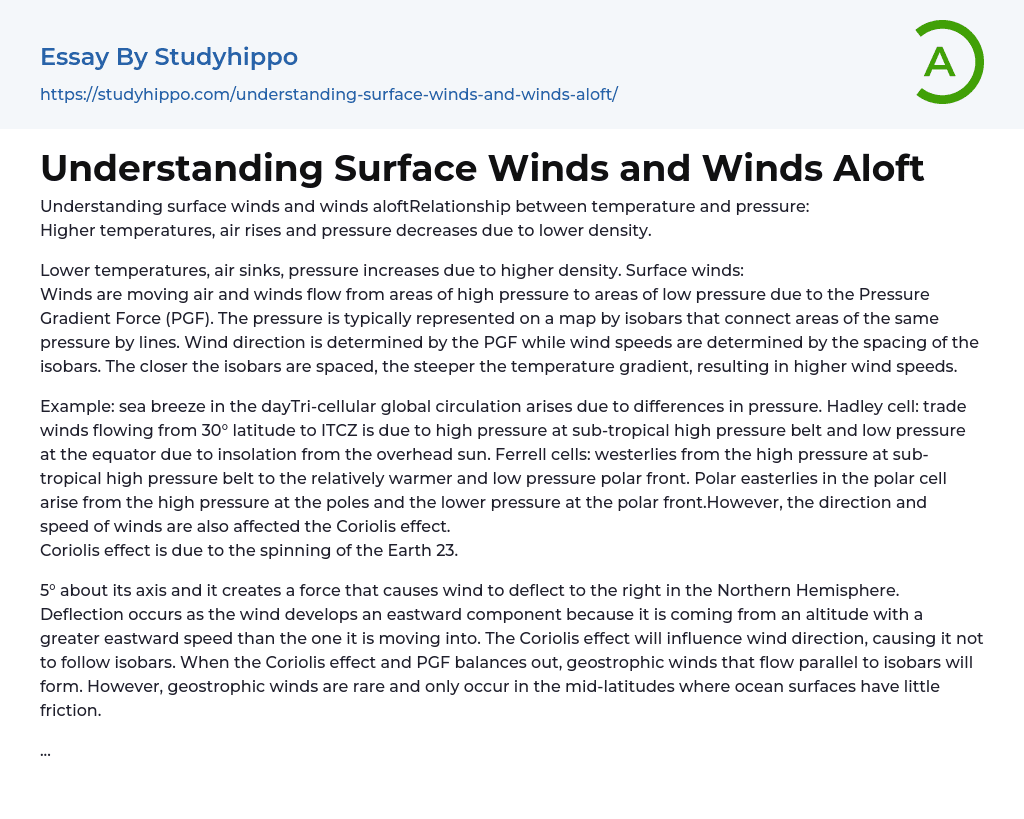

Understanding Surface Winds and Winds Aloft Essay Example
Understanding surface winds and winds aloftRelationship between temperature and pressure:
Higher temperatures, air rises and pressure decreases due to lower density.
Lower temperatures, air sinks, pressure increases due to higher density. Surface winds:
Winds are moving air and winds flow from areas of high pressure to areas of low pressure due to the Pressure Gradient Force (PGF). The pressure is typically represented on a map by isobars that connect areas of the same pressure by lines. Wind direction is determined by the PGF while wind speeds are determined by the spacing of the isobars. The closer the isobars are spaced, the steeper the temperature gradient, resulting in higher wind speeds.
Example: sea breeze in the dayTri-cellular global circulation arises due to differences in pressure. Hadley cell: tr
...ade winds flowing from 30° latitude to ITCZ is due to high pressure at sub-tropical high pressure belt and low pressure at the equator due to insolation from the overhead sun. Ferrell cells: westerlies from the high pressure at sub-tropical high pressure belt to the relatively warmer and low pressure polar front. Polar easterlies in the polar cell arise from the high pressure at the poles and the lower pressure at the polar front.However, the direction and speed of winds are also affected the Coriolis effect.
Coriolis effect is due to the spinning of the Earth 23.
5° about its axis and it creates a force that causes wind to deflect to the right in the Northern Hemisphere. Deflection occurs as the wind develops an eastward component because it is coming from an altitude with a greater eastward speed than the one it is moving into. Th
Coriolis effect will influence wind direction, causing it not to follow isobars. When the Coriolis effect and PGF balances out, geostrophic winds that flow parallel to isobars will form. However, geostrophic winds are rare and only occur in the mid-latitudes where ocean surfaces have little friction.
...
- Atmosphere essays
- Biodiversity essays
- Coral Reef essays
- Desert essays
- Earth essays
- Ecosystem essays
- Forest essays
- Lake essays
- Natural Environment essays
- Ocean essays
- Oxygen essays
- Rainbow essays
- Sea essays
- Soil essays
- Volcano essays
- Water essays
- Wind essays
- American Literature essays
- Between The World and Me essays
- Book Report essays
- Book Review essays
- Book Summary essays
- Books essays
- Character essays
- Coming of Age essays
- Dante's Inferno essays
- Everyday Use essays
- Flowers for Algernon essays
- Genre essays
- Greek Mythology essays
- Incidents in The Life of a Slave Girl essays
- Letter essays
- Literary Criticism essays
- Literary devices essays
- Literature Review essays
- Metaphor essays
- Myth essays
- Play essays
- Plot essays
- Poem essays
- Poetry Analysis essays
- Protagonist essays
- Reader essays
- Reason essays
- Rhetoric essays
- Rhetorical Question essays
- Rhyme essays
- Simile essays
- Tragic Hero essays
- Translation essays



